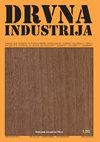接种曲霉和青霉真菌后松木片的化学和物理特性研究
IF 0.8
4区 农林科学
Q4 MATERIALS SCIENCE, PAPER & WOOD
引用次数: 0
摘要
代表青霉属和曲霉属的霉菌真菌通常在新鲜收获的木屑表面生长。因此,它们通常被认为是低质量的材料,打算焚烧。因此,本研究的目的是研究代表曲霉属和青霉属的霉菌真菌侵染木屑对其基本化学和物理性质的影响,如:化学结构(用FTIR光谱评估),质量损失和吸湿性,经过3周,6周和9周的培养。通过目测和麦角甾醇含量分析,发现木屑接种霉菌后,木屑表面真菌生长旺盛。然而,在FTIR光谱中观察到,霉菌的存在没有引起木材化学结构的变化。此外,没有观察到木材的质量损失和吸湿性显著增加。因此,被研究的真菌属覆盖的松木木屑似乎是一种有价值的材料,可用于各种应用。本文章由计算机程序翻译,如有差异,请以英文原文为准。
Selected Chemical and Physical Properties of Pine Wood Chips Inoculated with Aspergillus and Penicillium Mold Fungi
Mold fungi representing genera of Penicillium and Aspergillus commonly develop on the surface of freshly harvested wood chips during storage. As a result, they are often considered as low-quality material and intended for incineration. Thus, the aim of the present study was to investigate the effect of wood chips infestation with mold fungi representing genera of Aspergillus and Penicillium on their basic chemical and physical properties, such as: chemical structure (evaluated with FTIR spectroscopy), mass loss and hygroscopicity, after an incubation of 3, 6 and 9 weeks. Based on the visual assessment and ergosterol content analysis, it was found that inoculation of wood chips with molds led to the intense fungal development on their surface. However, as observed in FTIR spectra, the presence of molds caused no changes in wood chemical structure. Furthermore, no mass loss and no significant increase in the hygroscopicity of wood were observed. Therefore, pine wood chips overgrown by studied genera of fungi seem to be a valuable material for various applications.
求助全文
通过发布文献求助,成功后即可免费获取论文全文。
去求助
来源期刊

Drvna Industrija
MATERIALS SCIENCE, PAPER & WOOD-
CiteScore
1.80
自引率
9.10%
发文量
32
审稿时长
>12 weeks
期刊介绍:
"Drvna industrija" ("Wood Industry") journal publishes original scientific and review papers, short notes, professional papers, conference papers, reports, professional information, bibliographical and survey articles and general notes relating to the forestry exploitation, biology, chemistry, physics and technology of wood, pulp and paper and wood components, including production, management and marketing aspects in the woodworking industry.
 求助内容:
求助内容: 应助结果提醒方式:
应助结果提醒方式:


